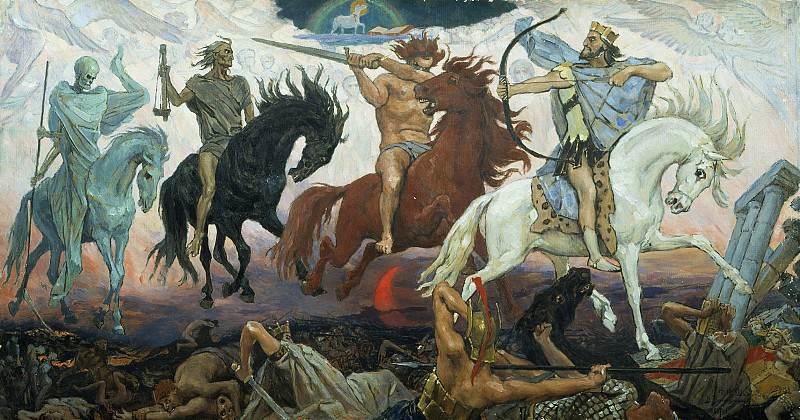The Four Horsemen of the Apocalypse Viktor Vasnetsov (1848-1926)
Viktor Vasnetsov – The Four Horsemen of the Apocalypse
Edit attribution
Download full size: 2290×1200 px (0,5 Mb)
Painter: Viktor Vasnetsov
Location: Museum of Religion and Atheism (History of Religion Museum), St. Petersburg (Государственный музей истории религии).
Victor Vasnetsov painted the canvas in 1887. It depicts the four horsemen from the sixth chapter of Revelations of John the Evangelist, these are biblical characters representing catastrophes on the eve of the end of the world, the Last Judgment. Vasnetsov depicted the horses appearing one after another. In the foreground is a rider on a white horse, destroying everything around him. He demolishes cities, the artist showed falling stone columns, around which people lie in horrific poses.
Description of Victor Vasnetsov’s painting "Wars of the Apocalypse
Victor Vasnetsov painted the canvas in 1887. It depicts the four horsemen from the sixth chapter of Revelations of John the Evangelist, these are biblical characters representing catastrophes on the eve of the end of the world, the Last Judgment.
Vasnetsov depicted the horses appearing one after another. In the foreground is a rider on a white horse, destroying everything around him. He demolishes cities, the artist showed falling stone columns, around which people lie in horrific poses. There is no one here: there are kings with a crown on their heads, elders, warriors preparing to fire their bows, and commoners. They all have one thing in common: the terrible grimace of anguish on their faces, of hopelessness, doom, and fear. These riders appear as if from the sky.
The rider on the white horse has a bow and on his head there is a crown as a symbol of power and victory. The white color is the embodiment of evil, the rider has a terrible grimace, he came here to defeat humanity, he goes straight over the heads.
The horseman marching behind him appeared on a red horse. He represents war. Vasnetsov painted him with a powerful muscular body and a sword drawn over the heads of the poor. The rider’s hair merges in color with the suit of horse. The rider on the red horse is dressed only in a band around his hip, the way gladiators used to perform. The flame color of his hair, the color of his horse and the sword he carries above his head represent the blood that has been spilt.
The third rider on the raven horse represents hunger, he is shown in ash-gray color, with scales in his hands. The figure of this rider is emaciated, his face lifeless, as if covered with bones. The scales are a symbol of false justice.
The last rider with the name death, the pale horse. The rider sitting on it has instead of the head skull and scythe in his hand, he - what is unnatural pale - green color. It is a symbol of hell.
Кому понравилось
Пожалуйста, подождите
На эту операцию может потребоваться несколько секунд.
Информация появится в новом окне,
если открытие новых окон не запрещено в настройках вашего браузера.
You need to login
Для работы с коллекциями – пожалуйста, войдите в аккаунт (open in new window).




















You cannot comment Why?
The painting depicts the Four Horsemen of the Apocalypse from the Book of Revelation. From left to right, the horsemen are:
The background is filled with a swirling, chaotic sky with angelic figures or spirits ascending and descending. Below the horsemen, a scene of devastation unfolds, with fallen soldiers, crowns, and broken pillars, signifying the destruction and downfall of humanity. The overall mood is apocalyptic and terrifying, conveying the immense power and finality of divine judgment. The subtext is the impending end of the world and the judgment of humanity, as foretold in religious prophecies.